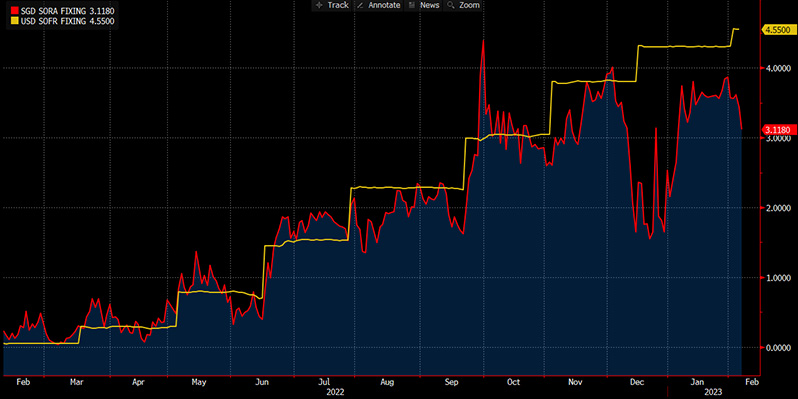Singapore Bond Markets: Sit Back, Lie Flat
The past years have provided great fodder for our imaginations to grow. It started with the Evergiven ship getting stuck in the Suez Canal in 2021, which was blamed for the disruptions and ensuing inflation in the global economy. The baton of blame was passed to Ukraine in 2022 and we enter 2023 with strange weather patterns and a giant Chinese air balloon to encourage the shenanigans on the political front. We wonder if Ukraine would want the war to end for the amount of aid they are receiving and how much more would they be demanding if the war did come to an end.
As for studies, statistics and correlations, we will not be taken in by random and pointless correlations. For example, there is no point in telling us vegans are less likely to be obese because of their diets when vegans are more likely to exercise and skip the cigarettes and booze.
Back to markets, we will not be accused of overthinking because we stand firm by our view that the person who is calling for the FED to pivot and cut rates in December is either a fortune-teller or a strategist because they cannot say they don’t know like us.
But when it comes to the Singapore bond market, our minds draw a blank and would rather follow a husky living in Paris called SORA on Instagram than think about our onshore interest rate benchmark. We decided to talk to some of our friends in the markets and hear their comments, so this post is a parody of sorts for a motley bunch of losers airing their gripes and frustrations in making their livelihoods off Singapore bonds (Singbonds). I hope that it may be of use to you even if it only manages to elicit just an ounce of sympathy.
After 20 years of following Singbonds, we are now busy googling behavioural finance courses available for our SkillsFuture Credit because it is getting too hard to make sense of markets. A dear friend sarcastically proclaimed it is easier to randomly correlate SORA fixings to the mating pattern of a gecko living in Sentosa for the lack of transparency of its derivation to the public and many market professionals because we do not have an interest rate benchmark and where on earth do we see the daily rates and volumes?
 Source: MAS
Source: MAS
Unlike the US Fed Funds which is a proper interest rate benchmark, SORA has absolutely no guidance as we can observe from the random walk chart below, which makes it worse for derivative fixings because it is backward-looking and we will only know what the 3-month SORA rate is three months later.
 Chart of the Random Walk of SORA fixings
Chart of the Random Walk of SORA fixings
Someone joked that the “A” in SORA should stand for “agak-agak ” in Malay, which means approximately because there is a disparity between the actual market funding interest rate and the overnight interbank rate (SORA) since the latter is inaccessible by anyone, even the likes of derivative traders who trade SORA derivatives.
Few really understand this fluctuating SORA rate which is the linchpin that spawns the universally referenced Singapore benchmark interest rate curve that everything is priced off.
It is perhaps a good thing too because nobody would blame our monetary policy for failing to contain inflation unlike the poor, lambasted Federal Reserve if we cannot figure it out although we have tried to write about it in the past, speculating that SORA could just be overnight SOR (Swap Offer Rate), its predecessor. This explains the volatility in the above graph and why we told friends mortgages should preferably not be pegged to 1-month compounded SORA unless they are feeling frisky.
Now why the rant on SORA and what has it to do with the bond market?
Everything is priced off the SORA rate curve, especially bonds! Pricing and more importantly, hedging the price risk.
To elaborate, for developed bond markets like the US dollar market, there are roughly three options to hedge—via SOFR interest rate swaps (similar to SORA), US treasuries and US treasury futures or SOFR futures. For Singapore, there are no other feasible means of hedging except for the SORA curve as it is virtually impossible to hedge by shorting government bonds. And bond futures do not exist because it is virtually impossible to short government bonds as the bond repo market is, let’s just say, undeveloped.
“No one dares to question SORA because it is not wrong until it is … I am not even trying to be funny and it affects Sing-rates like 10-year bonds,” to quote a fund manager we spoke to.
The mechanism of hedging on SORA requires one to pay a fixed rate to know their floating rate in one, three or six months, which would be easy for the rather stable US dollar curve (with the rate hikes priced-in along the way) but not so easy for whippy SORA. The floating rate is theoretically supposed to match the interest rate one pays to fund their bonds, which is again easy for the US market, but can be quite heart-attack-inducing for our febrile friends (we will not mention the OIS bit).
We confess we still have not worked out how banks are offering forward-looking SORA fixings for loans and mortgages but we admit to our intellectual limitations.
As such, many bond folks have given up hedging on the SORA curve and price bonds on instinct, using cash prices and other models which can be, euphemistically, described as frustrating.
“Maybe credit is the risk-free curve because prices don’t move until they do,” a fund manager proclaimed. And that was what happened last year with the precipitous meltdown of bond prices, unanchored by a benchmark curve.
It is a new normal for fresh faces, but for the folks who have been in the business for a while, it is mind-blowing that life has been reduced to “agak-agak.”
In SORA defence, a volume-weighted average rate would be far superior to the previous SOR benchmark which was depended on human integrity. Yet we now look back fondly on the SOR curve which was a simpler affair albeit the integrity bit, where you do not have to sit through six months of daily volatility to know your fate.
We miss the good old days when the rule book decrees that rates went down when inflation went up (which may possibly explain the dip in SORA late last year on the speculation that MAS would mete out an inter-meeting hike in January) and vice versa, for the perversity of the uniqueness of our monetary policy that has crowned the Singapore dollar as one of the top performing currencies since the dotcom crash.
All this has made us slightly paranoid at the back of our minds, that somewhere out there exists a small group of folks who have all the answers to our questions, who would have a hearty laugh if they read this half-baked post and advise us to “Give Up and Lie Flat” for curiosity can kill the cat and traders too.


